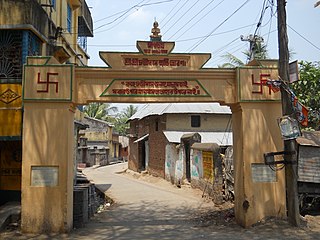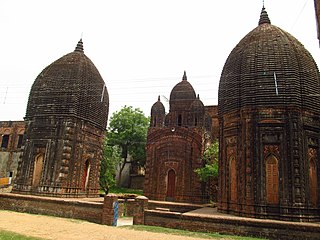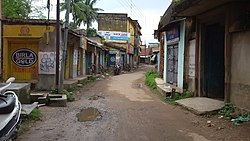
Kalna or Ambika Kalna is a town in the Purba Bardhaman district of West Bengal, India. It is the headquarter of the Kalna subdivision, situated on the western bank of the Bhāgirathi river. The town is more popularly known as Ambika Kalna, named after the goddess Kali, Maa Ambika. It has numerous historical monuments, such as the Rajbari, and 108 Shiva temples. The city of Kalna is 60 kilometres (37 mi) from Bardhaman.

Egra is a town in Purba Medinipur district in the state of West Bengal, India. It is the headquarters of the Egra subdivision. The ancient name of Egra was "Agrapattan".

Kharar is a historical town of Ghatal and one of the oldest town in Asia. This city is located in the Ghatal Subdivision of the Indian state of West Bengal.

Nanoor, is a village in Nanoor CD block in Bolpur subdivision of Birbhum district in West Bengal. Nanoor is the birthplace of 14th century lyric poet Chandidas of Vaishnava Padavali fame. It is developing as a craft centre with NGO support. With the massacres in 2000, Nanoor was in intense media focus.
Ilambazar is a census town, with a police station, in Ilambazar CD block in Bolpur subdivision of Birbhum district in the Indian state of West Bengal. A traditional weaving and trading centre it serves as a gateway to Birbhum district.
Boinchi is a Census town located in Hooghly District in the Indian state of West Bengal. It is under Pandua Police Station in Chinsurah subdivision. The town is located approximately 71 kilometers from Kolkata via Howrah-Bardhaman Main Line. The nearest Railway Station is Bainchi railway station, which is under the Eastern Railway and a part of Kolkata Suburban Railway System.
Hasanhati is a village in Kalna II CD block in Kalna subdivision of Purba Bardhaman district in West Bengal, India.

Debipur is a village located at Memari I block in Purba Bardhaman district. People called Debipur R.S. because there is a Railway Station. It is under Memari police station. Nearest railway station is Debipur railway station, which is under Eastern Railway and is a part of Kolkata Suburban Railway system. Debipur Railway Station is located in Alipur. Nearest towns near Debipur are Memari, Boinchi. Debipur R.S is a Post Office of many other villages like Alipur, Debipur R.S., Mobarakpur. There is two High School and many primary schools
Patrasayer is a village in the Patrasayer CD block in the Bishnupur subdivision of the Bankura district in the state of West Bengal, India.
Singarkone is a village in Kalna II CD block in Kalna subdivision of Purba Bardhaman district in the state of West Bengal, India.
Mankar is a village in Galsi I CD Block in Bardhaman Sadar North subdivision of Purba Bardhaman district in the state of West Bengal, India.
Hatgobindapur is a village in Burdwan II CD block in Bardhaman Sadar North subdivision of Purba Bardhaman district in the state of West Bengal, India.

Sribati or Sreebati is a village and gram panchayat in Katwa II CD block in the Katwa subdivision of Purba Bardhaman district of West Bengal.
Badla is a village in Kalna II CD block in Kalna subdivision of Purba Bardhaman district in the Indian state of West Bengal.

Supur is a village under Raipur-Supur gram panchayat in Bolpur Sriniketan CD block in Bolpur subdivision of Birbhum district, West Bengal, India.

Baidyapur Jora Deul is a 16th-century temple at Baidyapur in the Kalna II CD block in the Kalna subdivision of the Purba Bardhaman district in the Indian state of West Bengal.
Gumut is a village and gram panchayat in the Bishnupur CD block in the Bishnupur subdivision of the Bankura district in the state of West Bengal, India. It includes Muninagar.
Balsi Purbapara is a village in the Patrasayer CD block in the Bishnupur subdivision of the Bankura district in the state of West Bengal, India.
Bankati is a village in Kanksa CD block in the Durgapur subdivision of the Paschim Bardhaman district in the Indian state of West Bengal.

Bengal temple architecture is about temple styles developed and used in Bengal, particularly the chala, ratna and dalan temples.
















